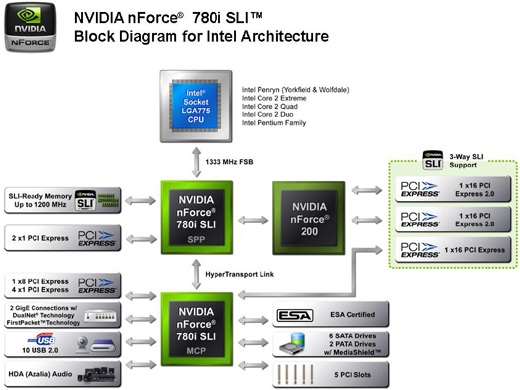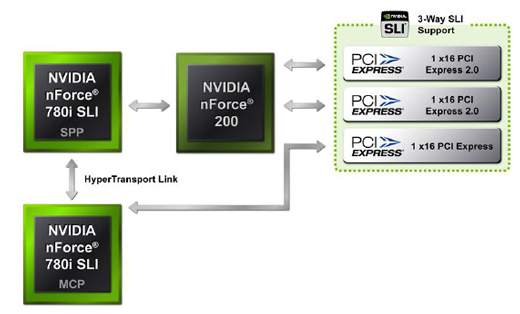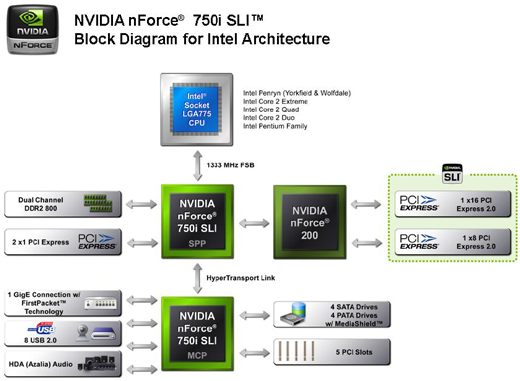
For last decade and more, NVidia has been on the representation of high quality graphics and powered numerous systems ranging from PC of a gaming enthusiast to high capacity workstation of a designer; NVIDIA cards are providing graphics solutions which suits every requirement and budget.
Nvidia also pioneered a concept of using more than one graphics cards in a system with its revolutionary SLI (Scalable Link Interface) technology

And now NVIDIA announced the next major step in graphics world, by announcing NVIDIA GeForce 8800 3-Way SLI, which incorporates 3 graphics cards which will give the user, a performance, never experienced before.
Since 780i is 680i with an added chip to support PCI 2.0 and two more x16 PCIe ports, it looked for a while as if NVIDIA might actually skip the 780i launch and wait until the DDR3 generation for a new chipset launch. Refinements for Penryn compatibility were completed and NVIDIA worked with Intel for Penryn family (Yorkfield quad-core and Wolfdale dual-core) compatibility certification.
Now, almost two months later, today is the official launch day of the 780i and 750i chipset. This is not just a paper launch, since 780i motherboards are available, or will be very soon, from NVIDIA launch partners XFX and EVGA. NVIDIA calls this the launch of the NVIDIA nForce 700i Series.
From a launch perspective, it is important to understand that 780i is not a new chipset. NVIDIA has said in their press releases, "The NVIDIA nForce 780i SLI MCP is built on TSMC's 90nm process technology, and contains the same micro-architecture as the NVIDIA nForce 680i SLI MCP. However, 780i SLI was designed with a high performance interface to be paired with nForce 200 to provide next-generation PCI Express 2.0 bus capabilities."
No use kidding around: NVIDIA GeForce 8800 3-Way SLI kicks benchmark ass. Reviewers across the board found the setup to be far and away the best money can buy when it comes to graphics, but the price is certainly steep. Not only are the cards super pricey -- you're limited to the 8800 GTX and 8800 Ultra -- but you'll need a 1000+ watt power supply, and pretty much a fresh system from the ground up unless you're already running the nForce 680i SLI or 780i SLI motherboard. PC Perspective crunched the numbers, and you're looking at about $2828 in costs before you even get to the case, hard drive, DVD drive and all that other superfluous stuff. That said, the third card really makes a big difference, since performance scales surprisingly well with the addition. You probably don't need this kind of power if you're not trying to game at full-res on a 30-incher, but if you don't mind dropping $3k on a system purely designed to play Crysis at Very High, then you just might have some 3-way SLI in your future.
Technical Specifications - (thanks to Anandtech.com)

3 SLI - how it works
nForce 780i Platform
NVIDIA targets their top chipset at the "hard-core overclocker", and each new generation adds more features that cater to the computer enthusiast. The nForce 780i tops the product line and defines state-of-the-art for NVIDIA chipsets.

The 780i is the 680i chipset with an added nForce 200 chip to support 32 lanes of PCIe 2.0 capabilities. This allows the addition of 3-way PCIe with three x16 PCIe slots. It is important to point out that while there are three x16 slots for 3-way SLI, only two of the x16 slots are PCIe 2.0 compliant. The third x16 slot is derived from the nForce 570 MCP (identified in the block diagram as the 780i SLI MCP), which is an older chip that is not PCIe 2.0 compliant.

nForce 750i Platform
The lower-priced 700i board is the 750i, an update to the current 650i chipset.
The 650i SLI has 18 PCIe lanes, which come from the SPP; the MCP does not supply any PCIe lanes. 750i follows the same pattern as 780i, with the SPP using the 16 PCIe lanes to communicate with the nForce 200 chip. The nForce 200 chip provides PCIe 2.0 compliant slots, but it is configured as one x16 slot and one x8 slot, where the 780i provides two x16 slots off the 200 chip.
This is an improvement over the 650i, which could be one x16 slot or two x8 slots. However, it is apparently not possible to split the 750i into three x8 PCIe 2.0 slots, for example, as the 780i can split into four x8 PCIe slots. Except for the added x8 PCIe 2.0 slot the port, slot and peripheral count remains the same as the 650i. 750i motherboards will not ship until January, so we will not have hands-on performance results for another 4-6 weeks.
System Design is as follows

Hope you guys enjoy soon with these high capacity gaming setups.
Read More about it
Offical Website of NVIDIA
on Anandtech.com
on engadget.com












1 comments